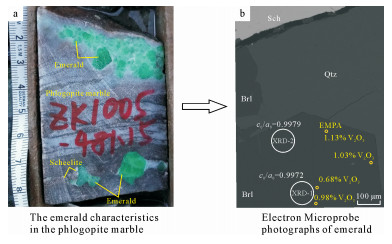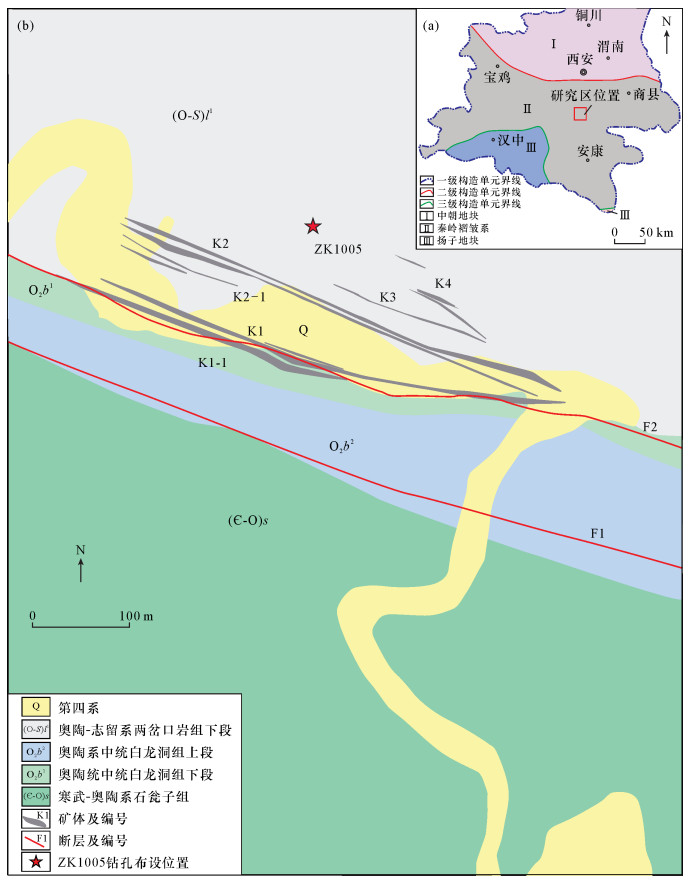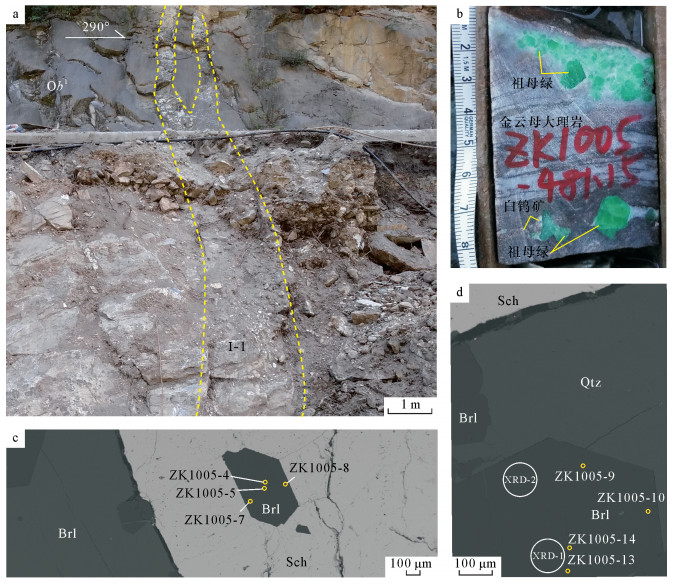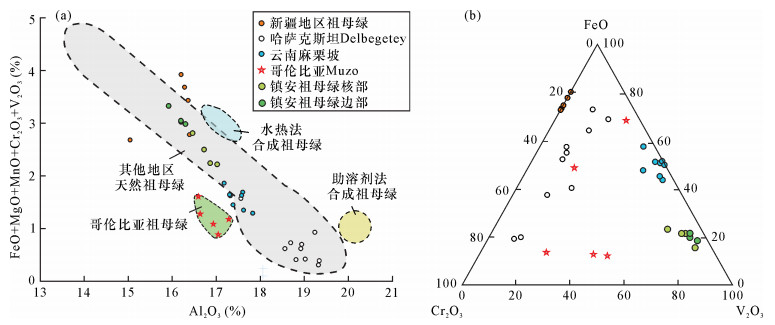Study on Emerald-level Beryl from the Zhen'an W-Be Polymetallic Deposit in Shaanxi Province by Electron Probe Microanalyzer and Micro X-ray Diffractometer
-
摘要: 南秦岭镇安地区发现了以白钨矿-绿柱石为矿石矿物组合的矿床新类型。为查明该矿床中首次发现的翠绿色祖母绿级绿柱石的致色机理并进一步揭示其成矿机制,本文在野外地质调查的基础上,对绿柱石开展了电子探针与微区X射线衍射等矿物学研究。结果表明:矿区中首次发现的祖母绿级绿柱石,呈自形晶产于石英(方解石)脉中并与白钨矿共(伴)生。祖母绿级绿柱石从核部至边缘V2O3含量较高,分别为0.64%~0.98%和1.04%~1.42%,且有增高趋势。X射线衍射数据表明区内祖母绿为“正常”绿柱石,同时存在Al↔Me2+和Be↔Li两种类质同象替换机制。V为本区祖母绿主要致色元素,来自于区内碳质板岩、金云母片岩及白云质大理岩等地层,Be、Si、Al等主要元素则来自于深部酸性岩浆岩。本次发现为该矿床中钨、铍矿产资源的综合开发利用提供了基础地质资料,并为南秦岭在区域及深部继续寻找稀有金属矿指出新的找矿方向。要点
(1) 利用电子探针和微区X射线衍射技术对陕西镇安地区首次发现的祖母绿级绿柱石开展致色机理和成因机制研究。
(2) 钒为镇安地区祖母绿主要致色元素,来自于区内碳质板岩、金云母片岩及白云质大理岩等地层。
(3) 镇安地区祖母绿属“正常”绿柱石,同时存在Al↔Me2+和Be↔Li两种类质同象替换机制。
HIGHLIGHTS(1) Electron Microprobe analysis and in-situ Micro X-ray Diffraction analysis were carried to study on chromatic mechanism and genetic mechanism of the newly discovered emerald in Zhen'an area, Shaanxi Province.
(2) Vanadium is the main coloring element of the emerald and derived from carbonaceous slate, mica schist and dolomitic marble.
(3) The emerald belongs to 'normal' beryl, and there are two kinds of isomorphous substitution mechanism including Al↔Me2+ and Be↔Li.
Abstract:BACKGROUND A new deposit type with a scheelite-beryl-molybdenite assemblage was first discovered in the Zhen'an area of Shaanxi Province.BAOBJECTIVES The research on chromatic mechanism and genetic mechanism of emerald was carried out.METHODS Combined with the geological survey, Electron Microprobe and in-situ Micro X-ray Diffractomer were used to conduct mineral research.RESULTS The emerald mainly occurs in the quartz (calcite) veins as euhedral crystal and is associated with scheelite. Both the core and rim of the emerald with high V2O3 contents of 0.64%-0.98% and 1.04%-1.42%, respectively, show an increased V2O3 trend from core to rim. Diffraction data show that the emerald is normal beryl and has two kinds of isomorphous substitution mechanism, Al↔Me2+ and Be↔Li. Vanadium is the main coloring element of emerald and was mainly derived from carbonaceous slate, mica schist, and dolomitic marble, whereas Be, Si and Al were derived from deep acidic igneous rocks.CONCLUSIONS The discovery provides basic geological data for the comprehensive development and utilization of tungsten and antimony mineral resources in the deposit, and indicates new prospecting directions for continued searching for rare metal deposits in the region and deep areas of the South Qinling.
-
Keywords:
- emerald /
- mineralogy /
- coloring mechanism /
- W-Be polymetallics /
- Southern Qinling
-
绿柱石是炼铍的主要矿物原料之一,色泽美丽者亦可作为宝石,其中最为珍贵的是被誉为“绿柱石之王”的祖母绿[1-2]。国内外众多学者[3-11]采用各种分析测试手段对天然及人工合成祖母绿的折射率[3]、相对密度[3]、特征包裹体[3-5]、晶体结构[5-8]、荧光[9]、光谱[10-22]等特征进行宝石学评价和矿物学研究。由于Be、Li属于超轻元素范围,利用电子探针直接定量测定尚存在技术难点[13],但仍能准确得出绿柱石中其他主量、微量元素含量。同时,微区X射线衍射(XRD)在对矿物单晶体中的特征显微及环带结构的研究中获得了创新性成果[14],因此,利用电子探针和微区XRD等测试手段可有效分析祖母绿中化学成分和结构特征,有助于进一步揭示其致色机理和成因机制等。
世界上优质的祖母绿主要分布在南美洲的哥伦比亚及巴西,非洲的津巴布韦、赞比亚、南非、坦桑尼亚等,亚洲的印度、巴基斯坦,俄罗斯的乌拉尔山脉等地[1-2]。虽然我国绿柱石矿产资源较丰富且分布广泛[1],但贵重的祖母绿宝石矿资源却极为匮乏,目前仅云南省麻栗坡祖母绿矿床及新疆地区具有一定开发前景,可见发现新的祖母绿宝石矿产地具有重要的经济意义。绿柱石产出多与伟晶岩有关[2, 15-18],而在实际地质过程中,酸性岩浆岩及其伟晶岩虽然能够提供绿柱石形成的主量元素(Be、Al、Si等),但无法提供进一步成为宝石级祖母绿的必要微量元素Cr、V等,需要区内发育基性-超基性岩或变质岩[19-22],甚至形成于与岩浆岩毫无关联的单一沉积岩[4, 23]。与此同时,世界范围内大部分祖母绿矿床均位于主要造山带附近,并主要产于古老的变质结晶基底中[20]。可见,稀有珍贵的祖母绿生成条件较为苛刻,因此除作为宝石学研究外,亦对揭示其成矿地质环境具有重要指示意义。
南秦岭地区有着漫长复杂的地史演化历史,经历多期次多旋回的沉积作用、岩浆活动和变质作用,具备形成优质宝石矿的有利地质条件。近年来,在该区取得一系列以钨为代表的稀有金属资源找矿突破,特别是在陕西镇安地区发现了首例以白钨矿-绿柱石为矿石矿物组合的钨矿床新类型,并在该矿床中首次发现石英脉型黑钨矿[24]及可达祖母绿级的绿柱石产出,对进一步揭示秦岭地区稀有金属矿产资源的成矿地质背景具有重要指示意义,也对寻找稀缺的祖母绿资源提供了新方向。本文在野外地质调查的基础上,利用电子探针及微区XRD等分析测试技术对该矿床中发现的祖母绿级绿柱石开展相关矿物学研究,分析其致色机理与成矿物质来源,以期为该矿床中铍资源的综合开发利用及深入研究秦岭地区稀有金属成矿机制提供基础数据资料。
1. 成矿地质背景与矿床地质特征
陕西省镇安地区产出的首例W-Be多金属矿床,大地构造位置处于秦岭褶皱系(Ⅰ)、南秦岭印支褶皱系带(Ⅱ)中(图 1a),区域构造变形强烈,总体构造线以东西向为主,印支运动对前期构造产生了叠加和改造,并伴随有大规模中酸性岩浆侵入。区域上划分出东江口燕山期中酸性(斑)岩体群,为细粒石英二长岩、花岗闪长岩等。其次为加里东期—华力西期,少量元古代小岩体。脉岩主要有闪长岩脉、云斜煌斑岩脉等。区域内矿化点分布广泛,主要有金、铁、铅、锌、钼、钨、黄铁矿等。金、铅、锌、钼、钨、黄铁矿的分布与EW-NWW向断裂带和奥陶系关系密切,受岩相和北西西向层间断裂蚀变带控制明显。
矿区内出露地层自南向北依次分布有寒武—奥陶系石瓮子组[(


![]() 图 2 陕西省镇安W-Be矿床野外地质及显微镜下特征a—Ob1地层中南北向石英脉型W-Be矿体野外露头;b—ZK1005岩心481.15 m处采集样品中绿柱石呈自形晶在石英脉中产出,边缘产出白钨矿;c, d—b图中样品切片局部BSE图像,绿柱石呈自形晶在白钨矿边缘及晶间产出,对应电子探针分析点和微区XRD分析点位置。Brl—绿柱石;Qtz—石英;Sch—白钨矿;ZK1005-4—电子探针测点及点位;XRD-1—绿柱石核部;XRD-2—绿柱石边部。Figure 2. Geological and microscopic characteristics of a W-Be deposit in Zhen'an, Shaanxi Province
图 2 陕西省镇安W-Be矿床野外地质及显微镜下特征a—Ob1地层中南北向石英脉型W-Be矿体野外露头;b—ZK1005岩心481.15 m处采集样品中绿柱石呈自形晶在石英脉中产出,边缘产出白钨矿;c, d—b图中样品切片局部BSE图像,绿柱石呈自形晶在白钨矿边缘及晶间产出,对应电子探针分析点和微区XRD分析点位置。Brl—绿柱石;Qtz—石英;Sch—白钨矿;ZK1005-4—电子探针测点及点位;XRD-1—绿柱石核部;XRD-2—绿柱石边部。Figure 2. Geological and microscopic characteristics of a W-Be deposit in Zhen'an, Shaanxi Province2. 样品采集与分析测试
本次分析测试样品采自矿区10号勘探线ZK1005深部481.15 m中的岩心,对指定部位进行切割抛光减薄等处理制成探针片,以备电子探针和微区X射线衍射分析测试使用。绿柱石的化学成分测定和背散射电子图像在中国地质科学院矿产资源研究所电子探针实验室完成,所用仪器型号为JEOLJXA-8100。测试条件为:加速电压15 kV,出射角40°,电流1×10-8 A,详细测试方法参见参考文献[25]。绿柱石(祖母绿)的晶体化学式以6个Si原子为基础计算,由于电子探针不能对Li和Be进行定量测定,本文Li2O和BeO的含量根据Li=Na+K+Rb+Cs和Be=3-Li计算所得[16],计算结果及对应分子式列于表 1。绿柱石的原位微区XRD分析在中南大学XRD实验室完成。仪器为理学D/max RapidⅡR型旋转阳极微区衍射仪,工作条件为:电压48 kV,电流250 mA,X射线束径100 μm,照射时间30 min,2θ范围20°~100°,D值(晶胞参数)测量准确度优于10-4 nm,采用MDI Jade5.0软件进行图谱分析,分析方法详见参考文献[14]。
表 1 陕西镇安某地绿柱石的电子探针分析结果Table 1. EMPA data of beryl in Zhen'an area, Shaanxi Province元素 核部 边部 ZK1005-4 ZK1005-5 ZK1005-13 ZK1005-14 平均值 ZK1005-7 ZK1005-8 ZK1005-9 ZK1005-10 平均值 SiO2 66.40 67.34 66.40 67.49 66.91 66.57 66.48 66.01 66.53 66.40 Al2O3 16.86 16.72 16.46 17.02 16.77 16.30 15.92 16.20 16.19 16.15 Na2O 0.71 0.80 0.76 0.69 0.74 0.80 0.85 0.74 0.82 0.80 K2O 0.03 0.01 0.03 0.03 0.03 0.04 0.03 0.02 0.04 0.03 CaO 0.02 0.02 0.01 0.03 0.02 0.01 / 0.01 0.02 0.01 TiO2 0.08 0.01 / 0.10 0.05 / 0.06 / / 0.02 P2O5 / 0.01 0.007 / / 0.01 / / 0.01 0.01 MgO 1.22 1.27 1.44 1.34 1.32 1.49 1.48 1.43 1.53 1.48 MnO 0.01 0.04 / 0 0.01 0.02 0 0.05 0 0.02 FeO 0.24 0.26 0.3 0.14 0.24 0.32 0.35 0.31 0.41 0.35 Rb2O / / / / / / / / / / Cs2O 0.06 0.04 0.05 0.05 0.05 0.10 0.05 0.06 0.05 0.07 V2O3 0.64 0.84 0.98 0.68 0.79 1.07 1.42 1.13 1.04 1.17 Cr2O3 0.13 0.10 0.09 0.06 0.10 0.08 0.07 0.09 0.07 0.08 BeO 12.93 12.81 12.61 13.08 12.86 12.47 12.18 12.44 12.39 12.37 Li2O 0.70 0.75 0.74 0.68 0.72 0.78 0.79 0.70 0.78 0.76 总计 100.01 101.15 100.02 101.48 100.67 100.06 99.76 99.27 99.96 99.76 元素 ZK1005-4 ZK1005-5 ZK1005-13 ZK1005-14 平均值 ZK1005-7 ZK1005-8 ZK1005-9 ZK1005-10 平均值 Si 6 6 6 6 6 6 6 6 6 6 Al 1.8 1.76 1.758 1.788 1.777 1.736 1.697 1.74 1.726 1.725 Na 0.124 0.138 0.134 0.12 0.129 0.14 0.148 0.131 0.143 0.141 K 0.003 0.001 0.004 0.003 0.003 0.005 0.004 0.002 0.004 0.004 Ca 0.002 0.002 0.001 0.003 0.002 0.001 / 0.001 0.001 0.001 Ti 0.005 0.001 / 0.007 0.004 / 0.004 / / 0.004 P / 0.001 0.001 / 0.001 0.001 / / 0.001 0.001 Mg 0.165 0.169 0.194 0.178 0.177 0.201 0.2 0.195 0.206 0.201 Mn 0.001 0.003 / / 0.002 0.002 / 0.004 / 0.003 Fe 0.018 0.019 0.023 0.01 0.018 0.024 0.026 0.024 0.031 0.026 Rb / / / / / / / / / / Cs 0.002 0.002 0.002 0.002 0.002 0.004 0.002 0.002 0.002 0.003 V 0.047 0.06 0.071 0.049 0.057 0.078 0.103 0.083 0.075 0.085 Cr 0.009 0.007 0.007 0.004 0.007 0.006 0.005 0.007 0.005 0.006 Li 0.13 0.141 0.139 0.125 0.134 0.149 0.154 0.135 0.149 0.147 Be 2.87 2.859 2.861 2.875 2.866 2.851 2.846 2.865 2.851 2.853 Mg+Fe+Mn+Cr+V 0.24 0.258 0.295 0.241 0.259 0.31 0.334 0.312 0.317 0.318 Mg+Mn+Fe 0.184 0.191 0.217 0.189 0.195 0.227 0.226 0.222 0.237 0.228 Na+K+Rb+Cs 0.13 0.141 0.139 0.125 0.134 0.149 0.154 0.135 0.149 0.147 注:①测试单位为中国地质科学院矿产资源研究所电子探针实验室;②“/”表示低于检测限;③绿柱石的晶体化学式以6个硅原子为基础计算,Li和Be原子数分别根据Li=Na+K+Rb+Cs和Be=3-Li。 3. 结果与讨论
3.1 绿柱石岩相学及成分特征
3.1.1 绿柱石岩相学特征
结合ZK1005中岩心样品手标本(图 2b)及电子显微镜下观察(图 2c),绿柱石常呈自形晶、半自形晶分布于白钨矿晶间或边缘,颜色多呈浅绿至深绿色,由核部至边部颜色略加深。当绿柱石颗粒较大时,白钨矿颗粒往往也较大,表现出较为密切的成生关系,绿柱石的形成与白钨矿近于同时或略晚于白钨矿。根据其质量和产出特征,祖母绿开发利用由优至劣可分为首饰级、观赏级、标本级和工业级四个等级[26]。就现有样品而言,矿区中大多数绿柱石已远超工业级达到标本级,同时采集岩心样品中绿柱石位于深部近500 m处,晶形、颜色及透明度均已达到观赏级甚至首饰级(图 2b),对应切片的背散射图像显示绿柱石矿物晶体较为完整且裂纹较少(图 2c, d),指示矿区深部极有可能存在着可观资源量的同级别绿柱石。
3.1.2 绿柱石成分特征
镇安地区祖母绿级绿柱石核部及边部的电子探针成分分析结果列于表 1,通过定量及理论计算,绿柱石核部分子式为Be2.859~2.875Al1.758~1.80(SiO3)6,BeO含量为12.61%~13.08%,Li2O含量为0.70%~0.75%;边部为Be2.846~2.865Al1.697~1.74(SiO3)6,BeO含量为12.18%~12.47%,Li2O含量为0.70%~0.79%。通过对比核部及边部中各元素含量的平均值(表 1),可见边部的SiO2、Al2O3及BeO主量元素成分相对核部表现为显著亏损; Na2O、MgO、FeO、V2O3、Li2O等微量元素成分则相对富集,指示为主要替代元素; 而K2O、CaO、TiO2、MnO、Cs2O、SnO2、Cr2O3等成分含量较低且相对变化量甚微。
3.2 绿柱石致色机理探讨与晶体结构分析
3.2.1 绿柱石致色机理
绿柱石中Be、Al配位数分别为4和6,其中Li主要替代[BeO4]四面体中的Be,而Fe2+、Mn2+、Mg2+、Fe3+、Cr3+、V5+和Ti4+等类质同象替代[AlO6]八面体,同时大半径离子K+、Na+、Cs+和Rb+进入通道电价补偿[27-28]。当绿柱石中含有一定量的不同价态微量元素而呈现不同颜色,如Fe2+使其为天蓝色,Fe3+为浅黄色,二者混合为黄绿色,Mn3+及Mn2+为紫红色,Cs+为淡红色。而绿柱石族中最珍贵的祖母绿,其绿色至翠绿色主要由Cr3+或(和)V3+引起,同时Fe3+、Fe2+会对其明度造成一定影响。镇安地区祖母绿成分特征与成因上独特的哥伦比亚祖母绿[4]明显不同,而表现为与其他地区的天然祖母绿的成分一致(图 3a)。由FeO-Cr2O3-V2O3三元图解(图 3b)显示,镇安地区祖母绿表现为V含量较高,而Cr含量很低,表明其翠绿色主要由V3+引起,与云南麻栗坡地区祖母绿[29]特征类似,但V含量更高,同时另含一定量的Fe,指示其具备成为优质宝石的基本条件。
![]() 图 3 镇安某地绿柱石与各地区典型祖母绿及合成祖母绿成分特征对比(a)及FeO-Cr2O3-V2O3三元图解(b)(a)新疆地区祖母绿数据引自文献[30],哈萨克斯坦Delbegetey祖母绿数据引自文献[3],云南麻栗坡祖母绿数据引自文献[29],哥伦比亚Muzo祖母绿数据引自文献[4];(b)除镇安绿柱石为本文数据外,其他数据点转引自文献[29],图例同(a)。Figure 3. (a) Summary of octahedral substitution components (FeO+MgO+MnO+Cr2O3+V2O3) vs. Al2O3 content in Zhen'an emeralds compared with other natural and synthetic emeralds. (b) Composition of emerald plotted in terms of FeO-Cr2O3-V2O3 in Zhen'an emeralds and beryls compared with other emeralds and beryls
图 3 镇安某地绿柱石与各地区典型祖母绿及合成祖母绿成分特征对比(a)及FeO-Cr2O3-V2O3三元图解(b)(a)新疆地区祖母绿数据引自文献[30],哈萨克斯坦Delbegetey祖母绿数据引自文献[3],云南麻栗坡祖母绿数据引自文献[29],哥伦比亚Muzo祖母绿数据引自文献[4];(b)除镇安绿柱石为本文数据外,其他数据点转引自文献[29],图例同(a)。Figure 3. (a) Summary of octahedral substitution components (FeO+MgO+MnO+Cr2O3+V2O3) vs. Al2O3 content in Zhen'an emeralds compared with other natural and synthetic emeralds. (b) Composition of emerald plotted in terms of FeO-Cr2O3-V2O3 in Zhen'an emeralds and beryls compared with other emeralds and beryls镇安地区祖母绿级绿柱石核部单位晶胞Mg+Fe+Mn+Cr+V(apfu)相对边部明显变大,且与Al(apfu)呈负相关关系,指示了Mg、Fe、Mn、Cr、V等元素对Al的替代,同时Na+K+Rb+Cs(apfu)与Mg+Mn+Fe(apfu)呈正相关关系,指示两组离子为替代补偿关系。
3.2.2 绿柱石晶体结构
对镇安钨-铍矿床中单一晶体的祖母绿的核部(XRD-1)及边缘(XRD-2)分别开展微区X射线衍射分析(图 4),结果显示核部d值(主要谱线)为4.6022(002)、3.2568(112)、2.2983(004),对应边部d值为4.6053(002)、3.2612(112)、2.2991(004)。如图 4所示,单颗粒祖母绿级绿柱石的核部及边部的衍射峰位和强度均与标准卡片(PDF 09-0430[31])中的绿柱石相吻合,表明为绿柱石族矿物。用MDI Jade 5.0软件对其进行晶胞参数计算,得出祖母绿核部a0=0.921935 nm,c0=0.919316(c0/a0=0.9972),边部a0=0.921726 nm,c0=0.919793(c0/a0=0.9979),明显大于绿柱石的理想晶胞参数(a0=0.9188 nm,c0=0.9189 nm),指示与Li和Mg、Fe、Mn、Cr、V、Sc等元素对Be和Al的替代有关,同时由核部至边部表现为a0值相对减小而c0值相对增大,这可能与其替代机制及替代程度有关。Aurisicchio等[28]根据类质同象置换对晶格参数的影响(c0/a0)将绿柱石分为三个系列:c0/a0=0.991~0.996为“八面体”置换型绿柱石;c0/a0=0.997~0.998为“正常”绿柱石;c0/a0=0.999~1.003则为“四面体”置换型绿柱石。镇安地区祖母绿的核部和边部均表现为“正常”绿柱石结构特征,指示同时存在Al
$\leftrightarrow $ Me2+和Be$\leftrightarrow $ Li两种类质同象替换机制。![]() 图 4 图 2d中单颗粒祖母绿级绿柱石核部及边部微区XRD分析Figure 4. Micro XRD analysis of the core and edge in the single particle of emerald-level beryl
图 4 图 2d中单颗粒祖母绿级绿柱石核部及边部微区XRD分析Figure 4. Micro XRD analysis of the core and edge in the single particle of emerald-level beryl3.3 南秦岭首例钨-铍矿床成因机制初探
有学者根据成矿作用与火成岩有无联系,大致将祖母绿矿床分为两种类型[32]:第Ⅰ类与花岗岩侵入体有关,花岗岩-伟晶岩侵入到富含Cr(±V)的岩石中(主要是基性、超基性岩),如加拿大Regal Ridge[22]、哈萨克斯坦Delbegetey[3]、马达加斯加Mananjary[33]和我国云南麻栗坡[29]、新疆塔什库尔干县地区祖母绿矿床[30, 34];第Ⅱ类则与花岗岩侵入体无关,矿化主要受构造(逆冲断层或剪切带)和地层控制,主要包括马达加斯加Ianapera[19]、阿富汗Panjsher[21]及哥伦比亚Muzo[4]。目前在镇安钨-铍矿床地表和钻孔中虽尚未发现岩浆岩,但在矿区南部及西部的外围均发育有较大规模的花岗岩体,同时从已有钻探工程的揭露情况来看,类矽卡岩化特征(图 2b)显著,指示深部极有可能发生了酸性岩浆的侵入活动。与绿柱石共生的白钨矿原位锶同位素组成为0.708~0.709(项目组未发表数据),介于地壳(0.718±0.020)和地幔(0.704±0.002)之间,更靠近地幔端员,进一步表明成矿流体为岩浆热液。与此同时,镇安祖母绿级绿柱石中的Mg含量明显高于云南麻栗坡和哥伦比亚Muzo等矿床中的祖母绿,并且Mg和V从晶体核部至边部均呈增高趋势,指示成矿热液与地层发生了较为强烈的交代作用。综合以上分析认为,本次在镇安地区发现的祖母绿级绿柱石的形成条件应属第Ⅰ类型,主要成矿物质Be来自于深部酸性岩浆,致色元素V及其中的替代元素Mg、Fe等则来自于区内的含钒地层及以金云母片岩、白云质大理岩为代表的变质沉积岩。
世界范围内大部分祖母绿矿床均位于主要造山带附近,并主要产于古老的变质结晶基底中[19-20]。镇安地区W-Be组合多金属矿床兼具以上特征,同时利用Re-Os同位素测得与绿柱石伴生的辉钼矿模式年龄为196.3±3.3 Ma[35],与同一区域内的东阳钨矿床成矿时代基本一致[36],进一步表明南秦岭地区在印支晚期—燕山早期阶段发生了强烈的挤压推覆,形成一系列南北向纵弯褶皱和东西向脆性-脆韧性断裂带并伴随中酸性岩浆侵入,为该区大规模钨(铍)矿化及局部地段形成祖母绿提供了有利的地质条件。
3.4 钨-铍矿床在镇安地区的发现对南秦岭进一步寻找稀有金属矿床的指示意义
秦巴地区作为我国中央造山带的核心部位,也是秦祁昆成矿区域的核心部位,在镇安地区发现以W-Be组合为特色的矿床,在南秦岭尚属首例,且产出有祖母绿级绿柱石,目前在同一成矿区带内尚未发现有类似矿物组合的已知矿床,为今后在秦岭寻找类似矿产资源拓展了新的领域。尤其值得重视的是,该类型矿床规模均不小,且资源潜力巨大[37],如云南东南部南温河一带的南秧田钨矿区(也是铍远景区),其钨的控制资源储量至少在30万吨以上。另外,还有西南三江金沙江沿线的麻花坪钨-铍矿床等规模较大。综上所述,目前正在镇安地区开展详查工作的该例含铍钨矿床具备良好的找矿远景,资源潜力较大,具有十分重要的经济和科学价值。本次新发现也为南秦岭地区在区域及深部指出了新的找矿方向。
4. 结论
通过对陕西镇安地区首例钨-铍多金属矿床中发现的祖母绿级绿柱石开展的相关矿物学研究,初步确认该区部分绿柱石的质量和产出特征均已达到观赏级甚至宝石级。该矿床中祖母绿级绿柱石呈现翠绿色是由于含有较高含量的V及Mg、Fe等替代元素,主要来源于区内含钒碳质地层及以金云母片岩、白云质大理岩为代表的变质沉积岩,Be来自于深部酸性岩浆。碱金属元素(Li、Na、K、Rb、Cs等)和铁镁质元素(Mg、Fe、V、Cr、Mn、Ti)对Al、Be的替代使其晶体结构发生一定变化,总体表现为“正常”绿柱石结构特征,同时存在Al
$\leftrightarrow $ Me2+和Be$\leftrightarrow $ Li两种类质同象替换机制。结合同位素及年代学证据,初步总结其成因机制为燕山早期发生酸性岩浆上侵,岩浆热液在向上运移过程中与地层发生了较为强烈的交代作用,并在构造有利部位形成较大规模的钨(铍)矿化。本次发现在一定程度上丰富了我国的宝石资源,并为镇安地区矿床中钨、铍矿产资源的综合开发利用提供了基础地质资料。
致谢: 中国地质科学院矿产资源研究所陈振宇教授级高级工程师在电子探针分析中提供了帮助,中南大学地球科学与信息物理学院谷湘平副教授和束正祥博士在微区X射线衍射分析和数据解译中提供了大力支持,在此一并致以诚挚谢意! -
图 2 陕西省镇安W-Be矿床野外地质及显微镜下特征
a—Ob1地层中南北向石英脉型W-Be矿体野外露头;b—ZK1005岩心481.15 m处采集样品中绿柱石呈自形晶在石英脉中产出,边缘产出白钨矿;c, d—b图中样品切片局部BSE图像,绿柱石呈自形晶在白钨矿边缘及晶间产出,对应电子探针分析点和微区XRD分析点位置。Brl—绿柱石;Qtz—石英;Sch—白钨矿;ZK1005-4—电子探针测点及点位;XRD-1—绿柱石核部;XRD-2—绿柱石边部。
Figure 2. Geological and microscopic characteristics of a W-Be deposit in Zhen'an, Shaanxi Province
图 3 镇安某地绿柱石与各地区典型祖母绿及合成祖母绿成分特征对比(a)及FeO-Cr2O3-V2O3三元图解(b)
(a)新疆地区祖母绿数据引自文献[30],哈萨克斯坦Delbegetey祖母绿数据引自文献[3],云南麻栗坡祖母绿数据引自文献[29],哥伦比亚Muzo祖母绿数据引自文献[4];(b)除镇安绿柱石为本文数据外,其他数据点转引自文献[29],图例同(a)。
Figure 3. (a) Summary of octahedral substitution components (FeO+MgO+MnO+Cr2O3+V2O3) vs. Al2O3 content in Zhen'an emeralds compared with other natural and synthetic emeralds. (b) Composition of emerald plotted in terms of FeO-Cr2O3-V2O3 in Zhen'an emeralds and beryls compared with other emeralds and beryls
图 4 图 2d中单颗粒祖母绿级绿柱石核部及边部微区XRD分析
Figure 4. Micro XRD analysis of the core and edge in the single particle of emerald-level beryl
表 1 陕西镇安某地绿柱石的电子探针分析结果
Table 1 EMPA data of beryl in Zhen'an area, Shaanxi Province
元素 核部 边部 ZK1005-4 ZK1005-5 ZK1005-13 ZK1005-14 平均值 ZK1005-7 ZK1005-8 ZK1005-9 ZK1005-10 平均值 SiO2 66.40 67.34 66.40 67.49 66.91 66.57 66.48 66.01 66.53 66.40 Al2O3 16.86 16.72 16.46 17.02 16.77 16.30 15.92 16.20 16.19 16.15 Na2O 0.71 0.80 0.76 0.69 0.74 0.80 0.85 0.74 0.82 0.80 K2O 0.03 0.01 0.03 0.03 0.03 0.04 0.03 0.02 0.04 0.03 CaO 0.02 0.02 0.01 0.03 0.02 0.01 / 0.01 0.02 0.01 TiO2 0.08 0.01 / 0.10 0.05 / 0.06 / / 0.02 P2O5 / 0.01 0.007 / / 0.01 / / 0.01 0.01 MgO 1.22 1.27 1.44 1.34 1.32 1.49 1.48 1.43 1.53 1.48 MnO 0.01 0.04 / 0 0.01 0.02 0 0.05 0 0.02 FeO 0.24 0.26 0.3 0.14 0.24 0.32 0.35 0.31 0.41 0.35 Rb2O / / / / / / / / / / Cs2O 0.06 0.04 0.05 0.05 0.05 0.10 0.05 0.06 0.05 0.07 V2O3 0.64 0.84 0.98 0.68 0.79 1.07 1.42 1.13 1.04 1.17 Cr2O3 0.13 0.10 0.09 0.06 0.10 0.08 0.07 0.09 0.07 0.08 BeO 12.93 12.81 12.61 13.08 12.86 12.47 12.18 12.44 12.39 12.37 Li2O 0.70 0.75 0.74 0.68 0.72 0.78 0.79 0.70 0.78 0.76 总计 100.01 101.15 100.02 101.48 100.67 100.06 99.76 99.27 99.96 99.76 元素 ZK1005-4 ZK1005-5 ZK1005-13 ZK1005-14 平均值 ZK1005-7 ZK1005-8 ZK1005-9 ZK1005-10 平均值 Si 6 6 6 6 6 6 6 6 6 6 Al 1.8 1.76 1.758 1.788 1.777 1.736 1.697 1.74 1.726 1.725 Na 0.124 0.138 0.134 0.12 0.129 0.14 0.148 0.131 0.143 0.141 K 0.003 0.001 0.004 0.003 0.003 0.005 0.004 0.002 0.004 0.004 Ca 0.002 0.002 0.001 0.003 0.002 0.001 / 0.001 0.001 0.001 Ti 0.005 0.001 / 0.007 0.004 / 0.004 / / 0.004 P / 0.001 0.001 / 0.001 0.001 / / 0.001 0.001 Mg 0.165 0.169 0.194 0.178 0.177 0.201 0.2 0.195 0.206 0.201 Mn 0.001 0.003 / / 0.002 0.002 / 0.004 / 0.003 Fe 0.018 0.019 0.023 0.01 0.018 0.024 0.026 0.024 0.031 0.026 Rb / / / / / / / / / / Cs 0.002 0.002 0.002 0.002 0.002 0.004 0.002 0.002 0.002 0.003 V 0.047 0.06 0.071 0.049 0.057 0.078 0.103 0.083 0.075 0.085 Cr 0.009 0.007 0.007 0.004 0.007 0.006 0.005 0.007 0.005 0.006 Li 0.13 0.141 0.139 0.125 0.134 0.149 0.154 0.135 0.149 0.147 Be 2.87 2.859 2.861 2.875 2.866 2.851 2.846 2.865 2.851 2.853 Mg+Fe+Mn+Cr+V 0.24 0.258 0.295 0.241 0.259 0.31 0.334 0.312 0.317 0.318 Mg+Mn+Fe 0.184 0.191 0.217 0.189 0.195 0.227 0.226 0.222 0.237 0.228 Na+K+Rb+Cs 0.13 0.141 0.139 0.125 0.134 0.149 0.154 0.135 0.149 0.147 注:①测试单位为中国地质科学院矿产资源研究所电子探针实验室;②“/”表示低于检测限;③绿柱石的晶体化学式以6个硅原子为基础计算,Li和Be原子数分别根据Li=Na+K+Rb+Cs和Be=3-Li。 -
胡荣荣, 张世涛.祖母绿矿床研究现状[J].化工矿产地质, 2006, 28(4):234-240. http://mall.cnki.net/magazine/Article/HGKC200604009.htm Hu R R, Zhang S T.Current research situation of the world emerald deposits and the existing problems[J].Geology of Chemical Minerals, 2006, 28(4):234-240. http://mall.cnki.net/magazine/Article/HGKC200604009.htm
胡荣荣, 张世涛.世界祖母绿矿床研究现状及存在问题[J].矿产与地质, 2007, 21(1):94-99. http://www.cnki.com.cn/Navi/A.htm Hu R R, Zhang S T.Status of worldwide emerald deposit research and some problems[J].Mineral Resources and Geology, 2007, 21(1):94-99. http://www.cnki.com.cn/Navi/A.htm
Gavrilenko E, Pérez B C, Bolibar R C, et al.Emeralds from the Delbegetey deposit (Kazakhstan):Mineralogical characteristics and fluid-inclusion study[J].Mineralogical Magazine, 2006, 70(2):159-173. doi: 10.1180/0026461067020321
Ottaway T L, Wicks F J, Bryndzia L T, et al.Formation of the Muzo hydrothermal emerald deposit in Colombia[J].Nature, 1994, 369:552-554. doi: 10.1038/369552a0
Bragg W L, West J.The structure of beryl, Be3Al2Si6O18[J].Royal Society of London Proceedings, 1926, 111(759):691-714. doi: 10.1098/rspa.1926.0088
刘琰, 邓军, 孙岱生, 等.四川虎牙雪宝顶W-Sn-Be矿床矿物学标型特征及流体对矿物形态的影响[J].地球科学——中国地质大学学报, 2007, 32(1):75-81. http://www.cnki.com.cn/Article/CJFD1997-KYDH701.007.htm Liu Y, Deng J, Sun D S, et al.Morphology and gensis typomorphism of minerals in W-Sn-Be deposit of Huya, Sichuan[J]. Earth Science-Journal of China University of Geosciences, 2007, 32(1):75-81. http://www.cnki.com.cn/Article/CJFD1997-KYDH701.007.htm
阮青锋, 张良钜, 张昌龙, 等.绿柱石的成因与特征的研究[J].矿产与地质, 2008, 22(3):265-269. https://www.wenkuxiazai.com/doc/40021281d4d8d15abe234e07-2.html Ruan Q F, Zhang L J, Zhang C L, et al.Genesis and characteristics of beryl[J].Mineral Resources & Geology, 2008, 22(3):265-269. https://www.wenkuxiazai.com/doc/40021281d4d8d15abe234e07-2.html
Garcí J M, Lastra A, Barriuso M T, et al.Origin of the different color of ruby and emerald[J].Physical Review B, 2005, 72(11):3104. http://www.mendeley.com/research/origin-different-color-ruby-emerald/
钟倩, 廖宗廷, 周征宇, 等.水热法合成Paraíba色绿柱石的宝石学特征[J].宝石和宝石学杂志, 2016, 18(6):1-7. http://www.wanfangdata.com.cn/details/detail.do?_type=perio&id=bshbsxzz200201009 Zhong Q, Liao Z T, Zhou Z Y, et al.Gemmological characteristics of hydrothermal synthetic paraíba-cloour beryl[J].Journal of Gems & Gemmology, 2016, 18(6):1-7. http://www.wanfangdata.com.cn/details/detail.do?_type=perio&id=bshbsxzz200201009
申柯娅.天然祖母绿与合成祖母绿的成分及红外吸收光谱研究[J].岩矿测试, 2011, 30(2):233-237. http://www.ykcs.ac.cn/article/id/ce380698-cdb7-491c-8284-258a85a55ac4 Shen K Y.Study on chemical compositions and infrared absorption spectra of natural and synthetic emeralds[J].Rock and Mineral Analysis, 2011, 30(2):233-237. http://www.ykcs.ac.cn/article/id/ce380698-cdb7-491c-8284-258a85a55ac4
梁婷.云南祖母绿的呈色机理初探[J].宝石和宝石学杂志, 2001, 3(4):21-24. http://www.wanfangdata.com.cn/details/detail.do?_type=perio&id=bshbsxzz200104006 Liang T.Study on coluration mechanism of emerald from Yunnan Province[J].Journal of Gems & Gemmology, 2001, 3(4):21-24. http://www.wanfangdata.com.cn/details/detail.do?_type=perio&id=bshbsxzz200104006
梁婷.祖母绿的红外光谱特征研究[J].长安大学学报(地球科学版), 2003, 25(2):10-13. http://www.cnki.com.cn/Article/CJFDTOTAL-RGJT201503003.htm Liang T.The study on infrared absorption pectroscopic characteristics of emeralds[J].Journal of Chang'an University (Earth Science Edition), 2003, 25(2):10-13. http://www.cnki.com.cn/Article/CJFDTOTAL-RGJT201503003.htm
张文兰, 王汝成, 蔡淑月.超轻元素Be元素的电子探针定量分析——以绿柱石为例[J].电子显微学报, 2006(增刊1):293-294. http://industry.wanfangdata.com.cn/dl/Detail/Conference?id=Conference_6347885 Zhang W L, Wang R C, Cai S Y.Quantitative analysis of ultralight element Be by electron microprobe-Taking beryl as an example[J].Journal of Chinese Electron Microscopy Society, 2006(Supplement 1):293-294. http://industry.wanfangdata.com.cn/dl/Detail/Conference?id=Conference_6347885
Liu J J, Zhai D G, Dai H Z, et al.Nanoscale character-ization of Au2Te grains from the Sandaowanzi gold deposit, Northeast China[J].The Canadian Mineralogist, 2017, 55(2):181-194. doi: 10.3749/canmin.1600077
Uher P, Chudík P, Bačík P, et al.Beryl composition and evolution trends:An example from granitic pegmatites of the beryl-columbite subtype, Western Carpathians, Slovakia[J].Journal of Geosciences, 2010, 55(1):69-80. http://www.oalib.com/paper/2807022
Wang R C, Che X D, Zhang W L, et al.Geochemical evolution and late re-equilibration of Na-Cs-rich beryl from the Koktokay #3 pegmatite (Altai, NW China)[J].European Journal of Mineralogy, 2009, 21(4):795-809. doi: 10.1127/0935-1221/2009/0021-1936
Viana R R, Jordtevangelista H, Costa G M D, et al.Characterization of beryl (aquamarine variety) from pegmatites of Minas Gerais, Brazil[J].Physics and Chemistry of Minerals, 2002, 29(10):668-679. doi: 10.1007/s00269-002-0278-y
Evensen J M.Beryllium in silicic magmas and the origin of beryl-bearing pegmatites[J].Reviews in Mineralogy & Geochemistry, 2002, 50(1):445-486. http://www.mendeley.com/research/beryllium-silicic-magmas-origin-berylbearing-pegmatites/
Sabot B.Fluid inclusions in Ianapera emerald, Southern Madagasca[J].International Geology Review, 2005, 47(6):647-662. doi: 10.2747/0020-6814.47.6.647
Moore T P. Emeralds of the World[M]//Mineralogical Record. 2003: 10-23, 25-33, 74-78.
Groat L A, Giuliani G, Marshall D D, et al.Emerald deposits and occurrences:A review[J].Ore Geology Reviews, 2008, 34(1-2):87-112. doi: 10.1016/j.oregeorev.2007.09.003
Groat L A, Marshall D D, Giuliani G, et al.Mineralogical and geochemical study of the Regal Ridge emerald showing, Southeastern Yukon[J].Canadian Mineralogist, 2002, 40(5):1313-1338. doi: 10.2113/gscanmin.40.5.1313
Cheilletz A, Féraud G, Giuliani G, et al.Time-pressure and temperature constraints on the formation of Colombian emeralds:An 40Ar/39Ar laser microprobe and fluid inclusion study[J].Economic Geology, 1994, 89:361-380. doi: 10.2113/gsecongeo.89.2.361
代鸿章, 王登红, 王成辉, 等.中央造山带秦巴地区发现石英脉型黑钨矿[J].岩矿测试, 2017, 36(5):559-560. doi: 10.15898/j.cnki.11-2131/td.201709040137 Dai H Z, Wang D H, Wang C H, et al.New discovery of quartz vein-type of wolframite ores in the Qinling-Daba area, Central Orogenic Belt, China[J].Rock and Mineral Analysis, 2017, 36(5):559-560. doi: 10.15898/j.cnki.11-2131/td.201709040137
许乃岑, 沈加林, 张静.X射线衍射-X射线荧光光谱-电子探针等分析测试技术在玄武岩矿物鉴定中的应用[J].岩矿测试, 2015, 34(1):75-81. doi: 10.15898/j.cnki.11-2131/td.2015.01.010 Xu N C, Shen J L, Zhang J.Application of X-ray diffraction, X-ray fluorescence spectrometry and electron microprobe in the identification of basalt[J].Rock and Mineral Analysis, 2015, 34(1):75-81. doi: 10.15898/j.cnki.11-2131/td.2015.01.010
刘永先, 范洪斌.云南祖母绿特征及开发利用初探[J].矿产综合利用, 1997(6):22-25. http://www.cnki.com.cn/Article/CJFDTOTAL-YNZD199704007.htm Liu Y X, Fan H B.A preliminary study on the characteristics and exploitation and utilization of emeralds in Yunnan[J].Multipurpose Utilization of Mineral Resources, 1997(6):22-25. http://www.cnki.com.cn/Article/CJFDTOTAL-YNZD199704007.htm
王濮, 潘兆橹, 翁玲宝, 等.统矿物学(中册)[M].北京:地质出版社, 1982:155-156. Wang P, Pan Z L, Weng L B, et al.Systematic Mineralogy (Volume 2)[M].Beijing:Geological Publishing House, 1982:155-156.
Aurisicchio C, Fioravanti G, Grubessi O, et al.Reappra-isal of the crystal chemistry of beryl[J].American Minealogist, 1988, 73:826-837. http://rruff.info/doclib/hom/beryl.pdf
黄文清, 倪培, 水汀, 等.云南麻栗坡祖母绿的矿物学特征研究[J].岩石矿物学杂志, 2015, 34(1):103-109. http://www.wanfangdata.com.cn/details/detail.do?_type=perio&id=yskwxzz201501009 Huang W Q, Ni P, Shui T, et al.Mineralogical characteristics of emerald from Malipo, Yunnan Province[J].Acta Petrologica et Mineralogica, 2015, 34(1):103-109. http://www.wanfangdata.com.cn/details/detail.do?_type=perio&id=yskwxzz201501009
任伟, 汪立今, 李甲平.电子探针和X射线衍射仪测定新疆祖母绿宝石[J].岩矿测试, 2010, 29(2):179-181. http://www.ykcs.ac.cn/article/id/5a9e1771-8bd3-42f9-b2fc-d5fe67a5c11f Ren W, Wang L J, Li J P. Detection of emerald from Xinjiang by electron probe microanalyzer and X-ray diffractometer[J].Rock and Mineral Analysis, 2010, 29(2):179-181. http://www.ykcs.ac.cn/article/id/5a9e1771-8bd3-42f9-b2fc-d5fe67a5c11f
JCPDS. International Center for Diffraction Data[Z]. [PDF#09-0430], 1988.
Schwartz D, Giuliani G.Emerald deposits:A review[J].Australian Gemmologist, 2001, 1:17-23. http://www.documentation.ird.fr/hor/fdi:010034445
Vapnik Y, Moroz I, Roth M, et al.Formation of emeralds at pegmatite-ultramafic contacts based on fluid inclusions in Kianjavato emerald, Mananjary deposits, Madagascar[J].Mineralogical Magazine, 2006, 70:141-158. doi: 10.1180/0026461067020320
汪立今, 彭雪峰, 李甲平, 等.新疆祖母绿(绿柱石)矿产出地质特征与找矿矿物学[J].矿物学报, 2011, 31(3):604-608. http://industry.wanfangdata.com.cn/dl/Magazine?magazineId=kwxb&yearIssue=2011_3 Wang L J, Peng X F, Li J P, et al.A study on basic geological characteristics and mineralogy of ore prospecting in Xinjiang emerald (beryl) deposit[J].Acta Mineralogica Sinica, 2011, 31(3):604-608. http://industry.wanfangdata.com.cn/dl/Magazine?magazineId=kwxb&yearIssue=2011_3
Dai H Z, Wang D H, Wang C H, et al.Re-Os isotopic dating of a W-Be polymetallic deposit in the Southern Qinling Region, China[J].Acta Geologica Sinica (English Edition), 2018, 92(1):414-415. doi: 10.1111/acgs.2018.92.issue-1
刘茜. 陕西镇安钨矿床特征及成因研究[D]. 北京: 中国地质大学(北京), 2013. http://cdmd.cnki.com.cn/Article/CDMD-11415-1013270343.htm Liu Q. The Characterisitcs and Genesis of the Zhen'an W Deposit, Shannxi Province, China[D]. Beijing: China University of Geoscinces (Beijing), 2013. http://cdmd.cnki.com.cn/Article/CDMD-11415-1013270343.htm
盛继福, 王登红.中国矿产地质志·钨矿卷[M].北京:地质出版社(待出版), 2018. Sheng J F, Wang D H.China's Mineral Geology (Tungsten Ore Volume)[M].Beijing:Geological Publishing House, 2018(in press).
-
期刊类型引用(21)
1. 郭春丽,张斌武,郑义,许箭琪,赵迁迁,闫金禹,周睿,符伟,黄可. 中国花岗岩型锂矿床:重要特征、成矿条件及形成机制. 岩石学报. 2024(02): 347-403 .  百度学术
百度学术
2. 姜军胜,郭欣然,徐净,田立明,熊光强,王力圆,陈素余,黄维坤. 江西甘坊洞上稀有金属花岗岩中铷矿化特征及成因机制. 地质通报. 2024(01): 86-100 .  百度学术
百度学术
3. 刘金宇,王成辉,刘善宝,秦锦华,陈振宇,刘泽,赵晨辉. 赣西北狮子岭花岗岩型锂矿床成因:来自岩石地球化学和锆石U-Pb年代学的约束. 矿床地质. 2024(01): 195-214 .  百度学术
百度学术
4. 徐喆,张芳荣,张福神,王光辉,吴俊华,唐维新,楼法生,谢春华,高原,董菁,陈军,况二龙,周宾. 江西九岭南缘蚀变花岗岩型锂矿床成矿地质特征及找矿方向. 矿床地质. 2024(02): 244-264 .  百度学术
百度学术
5. 吴福元,郭春丽,胡方泱,刘小驰,赵俊兴,李晓峰,秦克章. 南岭高分异花岗岩成岩与成矿. 岩石学报. 2023(01): 1-36 .  百度学术
百度学术
6. 陈振宇,李建康,周振华,高永宝,李鹏. 硬岩型锂-铍-铌-钽资源工艺矿物学评价指标体系. 岩石学报. 2023(07): 1887-1907 .  百度学术
百度学术
7. 刘泽,陈振宇,王成辉. 赣西北狮子岭花岗岩型锂-钽矿床的矿物学特征及成矿机制. 岩石学报. 2023(07): 2045-2062 .  百度学术
百度学术
8. 徐净,侯文达,王力圆,赵太平,陈素余,田立明. 稀有金属花岗岩结晶分异过程中铷的富集与成矿:来自江西甘坊岩体的矿物学证据. 地质学报. 2023(11): 3766-3792 .  百度学术
百度学术
9. 聂晓亮,王水龙,刘爽,徐林. 江西茜坑锂矿床地质地球化学特征与锂云母~(40)Ar/~(39)Ar年代学研究. 矿物学报. 2022(03): 285-294 .  百度学术
百度学术
10. 邓红云,钟盛文,刘雨鑫,彭卫发,张绍军. 硫酸法从锂磷铝石中提取锂工艺研究及优化. 有色金属科学与工程. 2022(04): 35-43 .  百度学术
百度学术
11. 王水龙,王大钊,刘爽,廖生万,聂晓亮,李凯旋,徐林,周宾. 江西甘坊岩体发现罕见的含铍矿物——红磷锰铍石. 岩矿测试. 2022(04): 688-690 .  本站查看
本站查看
12. 甘德清,田晓曦,刘志义,高锋. 循环冲击状态下砂岩力学及损伤特性研究. 中国矿业. 2021(03): 203-211 .  百度学术
百度学术
13. 黄传冠,贺彬,夏明,周渝,胡为正. 赣南地区伟晶岩型锂矿资源禀赋特征与找矿新进展. 中国矿业. 2021(03): 212-216+223 .  百度学术
百度学术
14. 李超,王登红,屈文俊,孟会明,周利敏,樊兴涛,李欣尉,赵鸿,温宏利,孙鹏程. 关键金属元素分析测试技术方法应用进展. 岩矿测试. 2020(05): 658-669 .  本站查看
本站查看
15. 张勇,潘家永,马东升. 赣西北大湖塘钨矿富锂-云母化岩锂元素富集机制及其对锂等稀有金属找矿的启示. 地质学报. 2020(11): 3321-3342 .  百度学术
百度学术
16. 刘善宝,杨岳清,王登红,代鸿章,马圣钞,刘丽君,王成辉. 四川甲基卡矿田花岗岩型锂工业矿体的发现及意义. 地质学报. 2019(06): 1309-1320 .  百度学术
百度学术
17. 王登红. 关键矿产的研究意义、矿种厘定、资源属性、找矿进展、存在问题及主攻方向. 地质学报. 2019(06): 1189-1209 .  百度学术
百度学术
18. 王成辉,王登红,陈晨,刘善宝,陈振宇,孙艳,赵晨辉,曹圣华,凡秀君. 九岭式狮子岭岩体型稀有金属成矿作用研究进展及其找矿意义. 地质学报. 2019(06): 1359-1373 .  百度学术
百度学术
19. 屈文俊,王登红,朱云,樊兴涛,李超,温宏利. 稀土稀有稀散元素现代仪器测试全新方法的建立. 地质学报. 2019(06): 1514-1522 .  百度学术
百度学术
20. 王登红,郑绵平,王成辉,高树学,商朋强,杨献忠,樊兴涛,孙艳. 大宗急缺矿产和战略性新兴产业矿产调查工程进展与主要成果. 中国地质调查. 2019(06): 1-11 .  百度学术
百度学术
21. 夏明,贺彬. 江西省宁都县三坑地区新发现磷锂铝石富锂矿物. 世界有色金属. 2018(22): 222-223 .  百度学术
百度学术
其他类型引用(3)




 下载:
下载:



 京公网安备 11010202008159号
京公网安备 11010202008159号